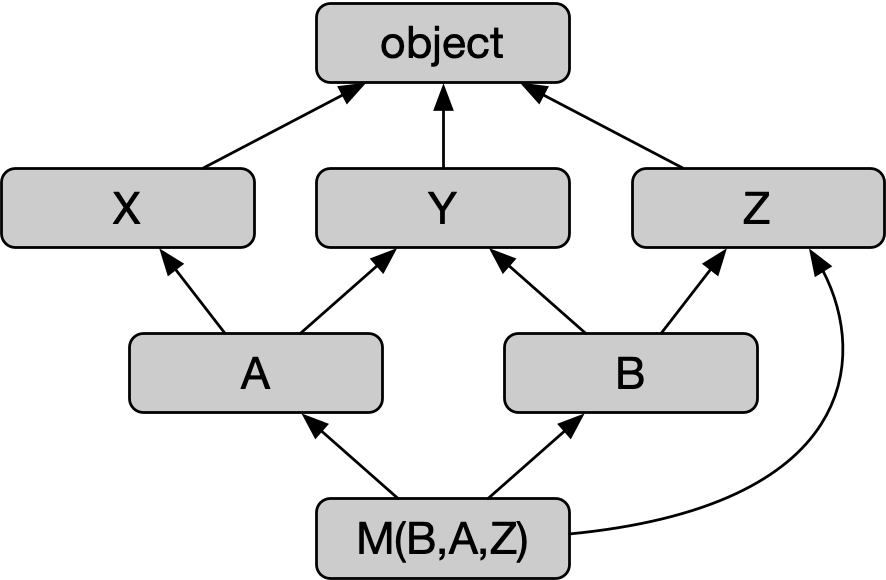C3 Linearization and Python MRO(Method Resolution Order)
Table of Contents
Python supports multiple inheritance, its class can be derived from more than one base classes. If the specified attribute or methods was not found in current class, how to decide the search sequence from superclasses? In simple scenario, we know left-to right, bottom to up. But when the inheritance hierarchy become complicated, it’s not easy to answer by intuition.
For instance, what’s search sequence of class M?
class X:pass
class Y: pass
class Z:pass
class A(X,Y):pass
class B(Y,Z):pass
class M(B,A,Z):pass

The answer is: M, B, A, X, Y, Z, object
C3 Algorithm #
How did Python generate this sequence? After Python 2.3, it use C3 Linearization algorithm.
C3 follows these two equation:
L[object] = [object]
L[C(B1…BN)] = [C] + merge(L[B1]…L[BN], [B1, … ,BN])
L[C] is the MRO of class C, it will evaluate to a list.
The key process is merge, it get a list and generate a list by this way:
- First, check the first list’s head element(
L[B1]) as H. - If H is not in the tail of other list, output it, and remove it from all of the list, then go to step 1. Otherwise, check the next list’s head as H, go to step 2. (tail means the rest of the list except the first element)
- If merge’s list is empty, end algorithm. If list is not empty but not able to find element to output, raise error.
That seems complicated, I’ll use the previous example again to explain the calculation of C3.
Let’s begin with the easy ones. Firstly, calculate A’s MRO:
L[A(X,Y)]=[A]+merge(L[X],L[Y],[X,Y])
=[A]+merge([X,obj],[Y,obj],[X,Y])
# X is not tail of other list, use it as H
=[A,X]+merge([obj],[Y,obj],[Y])
# obj is in the tail of[Y.obj], use Y as H
=[A,X,Y]+merge([obj],[obj]]
=[A,X,Y,obj]
B’s MRO [B,Y,Z,obj] and Z’s MRO [z,obj] can also be calculated.
Now we can get M’s MRO:
L[M(B,A,Z)]=[M]+merge(L[B],L[A],L[Z],[B,A,Z])
=[M]+merge([B,Y,Z,obj],[A,X,Y,obj],[Z,obj],[B,A,Z])
=[M,B]+merge([Y,Z,obj],[A,X,Y,obj],[Z,obj],[A,Z])
# Y is in the tail of [A,X,Y,obj], use A as H
=[M,B,A]+merge([Y,Z,obj],[X,Y,obj],[Z,obj],[Z])
# Y is in the tail of [X,Y,obj], use X as H
=[M,B,A,X]+merge([Y,Z,obj],[Y,obj],[Z,obj],[Z])
=[M,B,A,X,Y]+merge([Z,obj],[obj],[Z,obj],[Z])
=[M,B,A,X,Y,X]+merge([obj],[obj],[obj])
=[M,B,A,X,Y,X,obj]
MRO and super() #
super also use C3 to find the inherited method to execute.
For instance, C’s MRO is C,A,B,Base,obj, so after enter A, it will output enter B rather than enter base.
class Base:
def __init__(self):
print('enter base')
print('leave base')
class A(Base):
def __init__(self):
print('enter A')
super(A, self).__init__()
print('leave A')
class B(Base):
def __init__(self):
print('enter B')
super(B, self).__init__()
print('leave B')
class C(A, B):
def __init__(self):
print('enter C')
super(C, self).__init__()
print('leave C')
c = C()
enter C
enter A
enter B
enter base
leave base
leave B
leave A
leave C
super works like this, it will get inst’s MRO, find cls’s index, return next class in MRO. (In python3, super(A,self) can be write as super())
def super(cls, inst):
mro = inst.__class__.mro()
return mro[mro.index(cls) + 1]
When running this line super(C, self).__init__(), self is C’s instance, mro is:
[<class '__main__.C'>, <class '__main__.A'>, <class '__main__.B'>, <class '__main__.Base'>, <class 'object'>]
So it returns A, and A will execute __init__(), then calling super(A, self).__init__(), end enter B’s __init__(). (C’s instance inst will pass as self in the calling chain.)